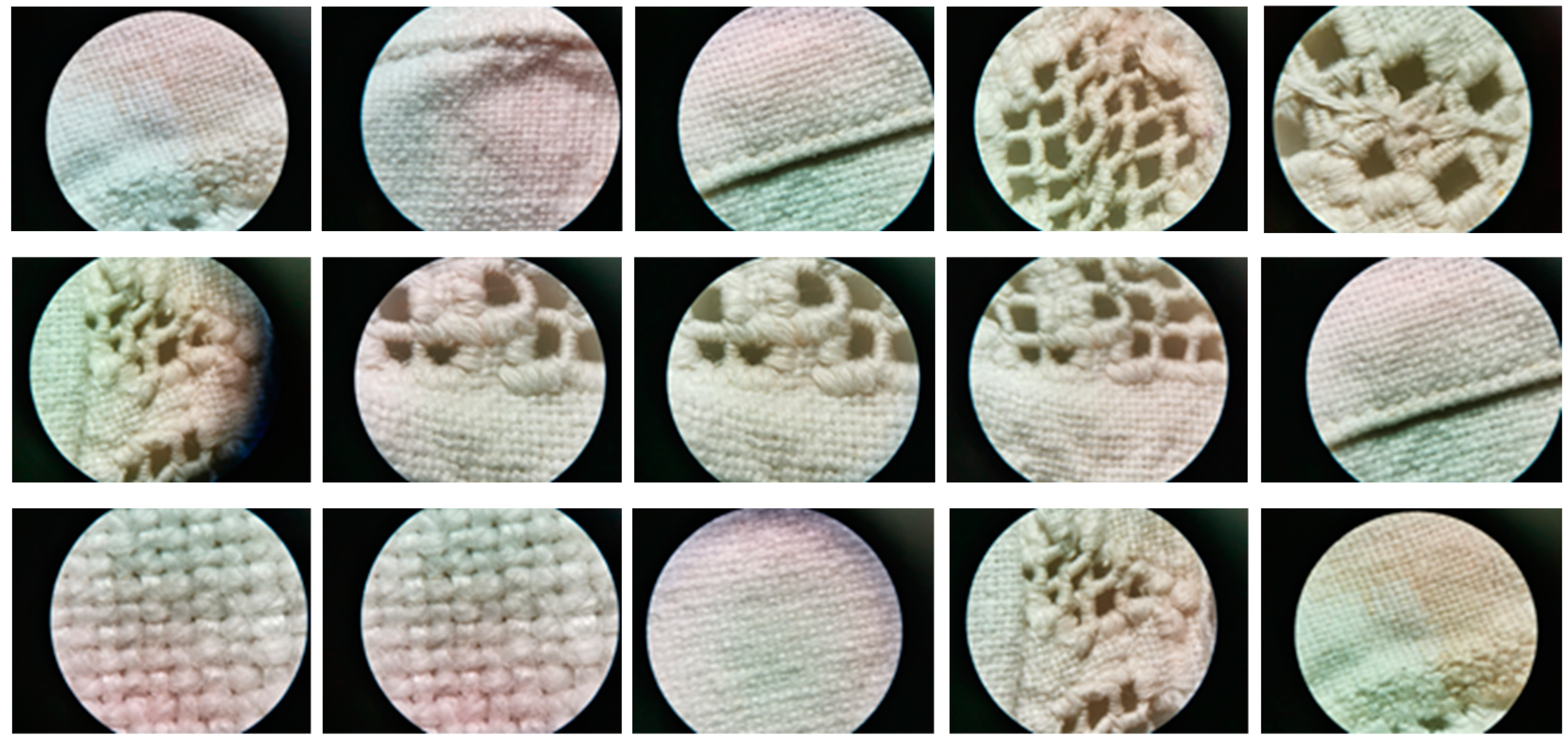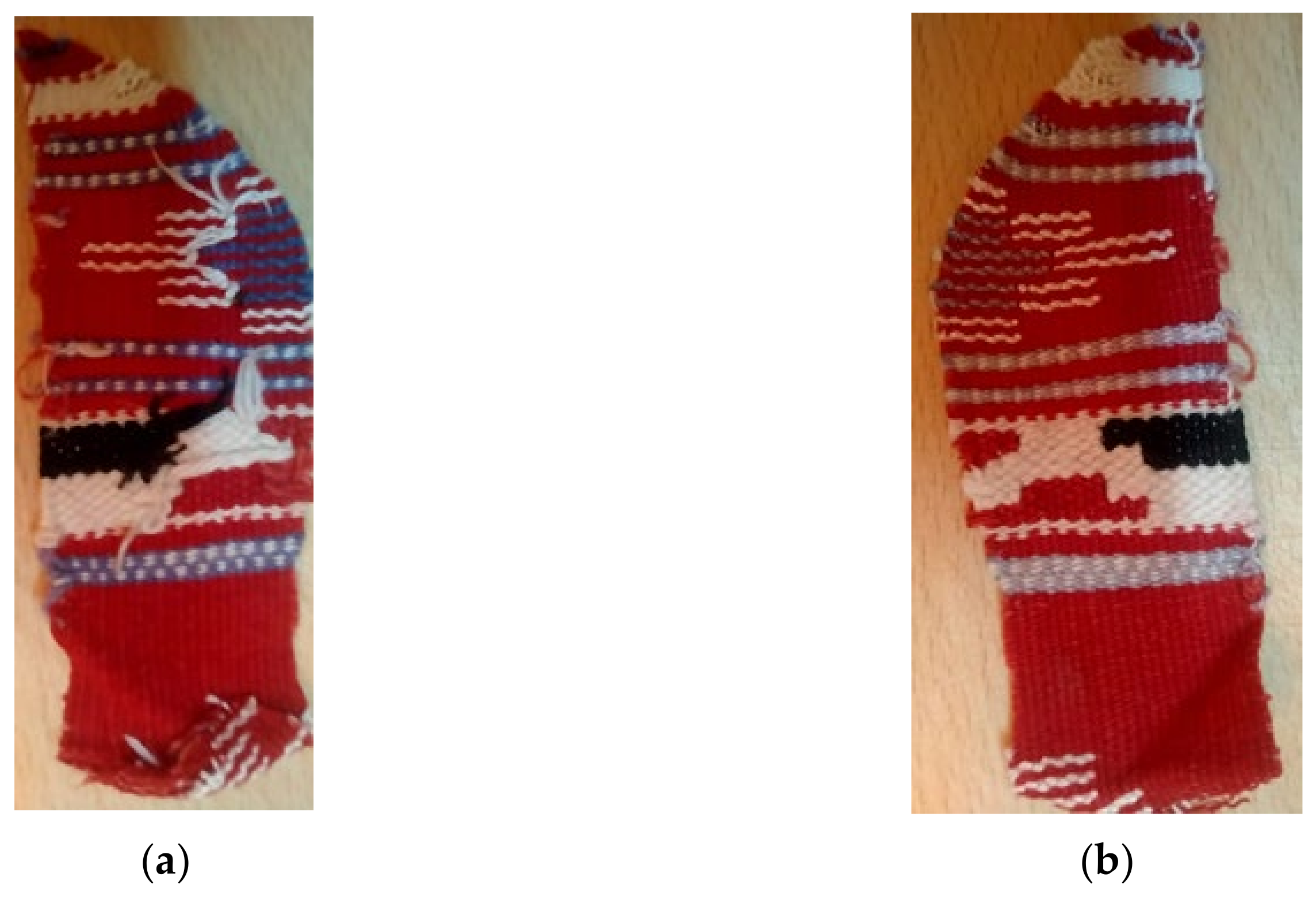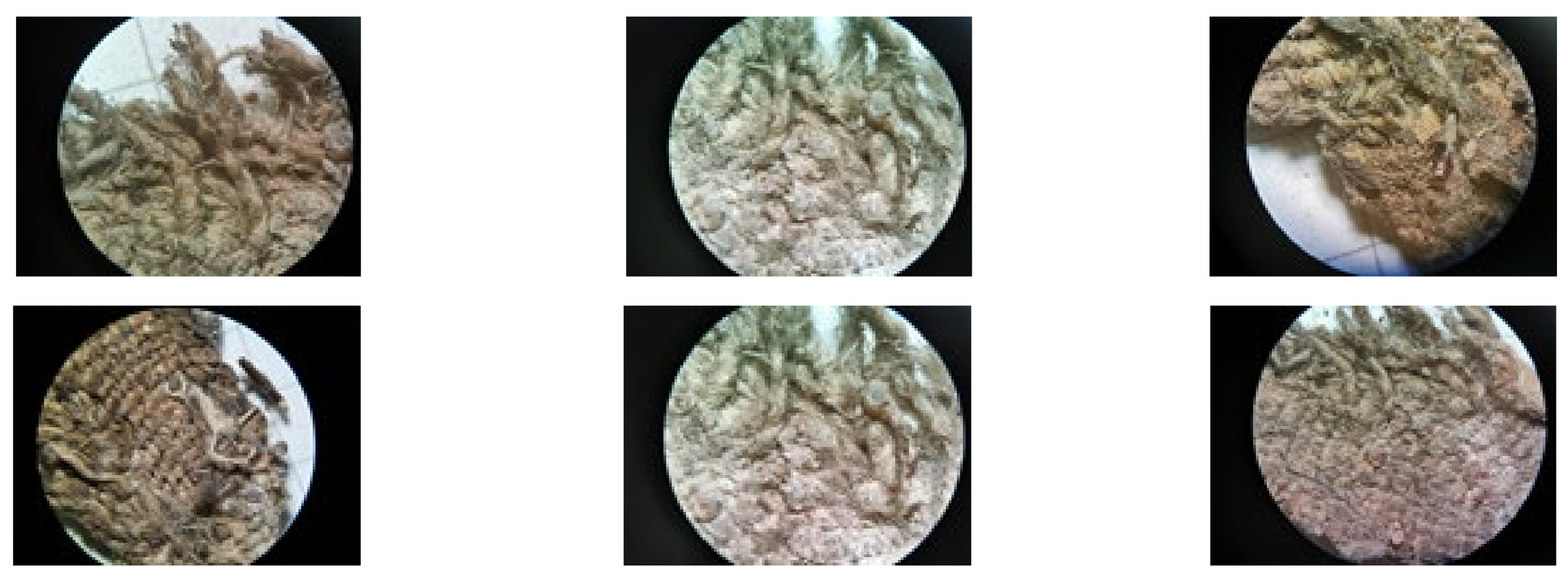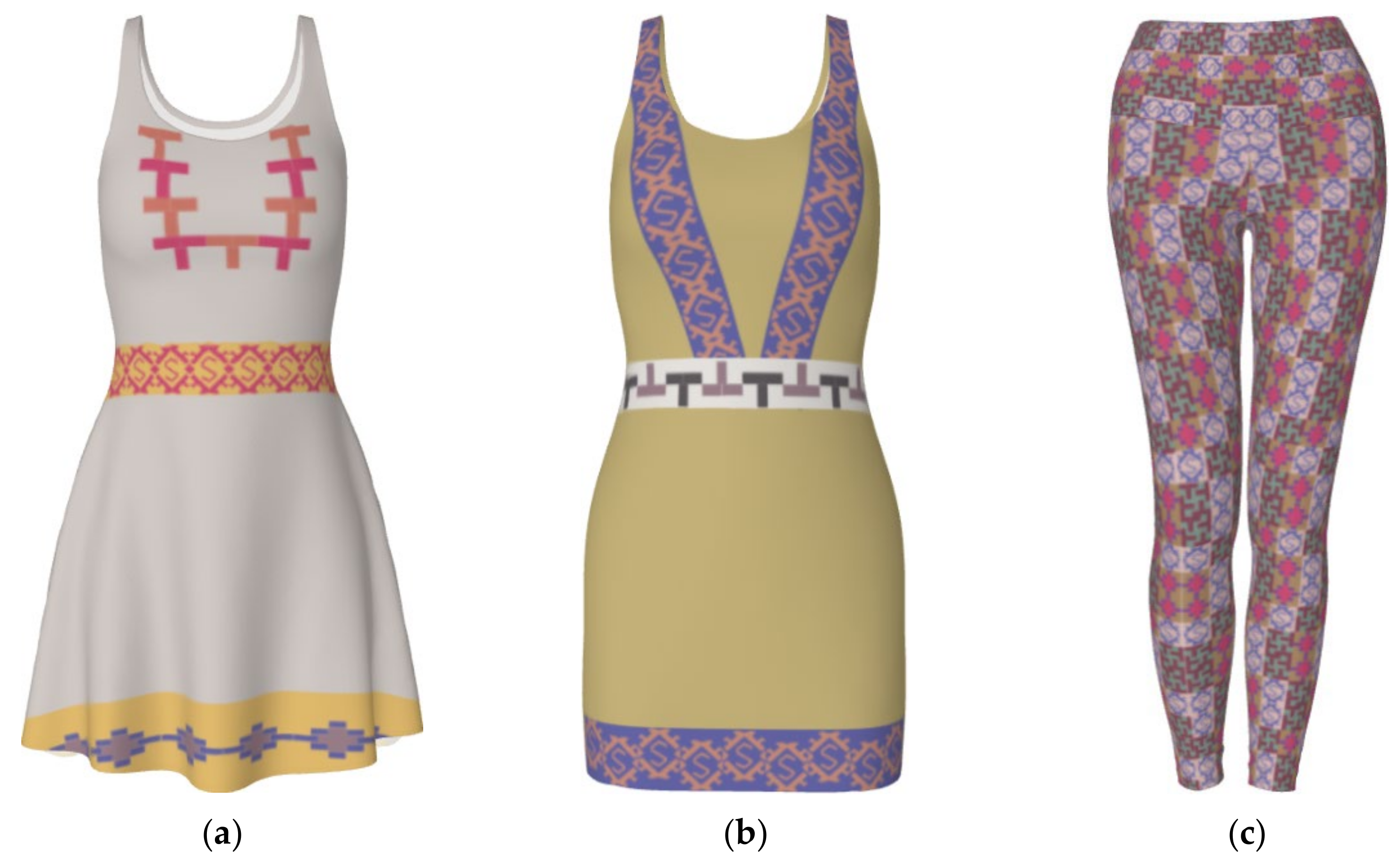Rare Romanian Ethnographic Textiles—Reverse Engineering of Fabrics for Fashion Trends
Abstract
:1. Introduction
2. Materials and Methods
2.1. Methods and Tools
2.1.1. Regression Model
2.1.2. Software Tools
2.2. Materials
2.2.1. Specimen 1
2.2.2. Specimen 2
2.2.3. Specimen 3
2.2.4. Specimen 4
2.2.5. Specimen 5
2.2.6. Specimen 6
2.3. Analysis of Fabric Structures Yarn Specification Reconstruction of Fabrics
3. Results and Discussion
3.1. Results from Specimens’ Measurements
3.2. Results from Analysis of Fabric Structures
3.3. Results from Yarn Specification
3.4. Results from the Reconstruction of the Fabrics
3.5. Analysis of Texture Features
3.6. Simulation in Fashion Trends
4. Conclusions
Author Contributions
Funding
Institutional Review Board Statement
Informed Consent Statement
Data Availability Statement
Conflicts of Interest
References
- Ilies, A.; Grama, V. The external Western Balkan border of the European Union and its borderland: Premises for building functional transborder territorial systems. Ann. Istrian Mediterr. Stud. Ser. Hist. Sociol. 2010, 20, 457–469. [Google Scholar]
- Wendt, J.A.; Pashkov, S.V.; Mydłowska, E.; Bógdał-Brzezińska, A. Political and Historical Determinants of the Differentiation of Entrepreneurial Ecosystems of Agritourism in Poland and Kazakhstan. Sustainability 2021, 13, 10487. [Google Scholar] [CrossRef]
- Pereira Roders, A.; van Oers, R. Editorial: Bridging cultural heritage and sustainable development. J. Cult. Herit. Manag. Sustain. Dev. 2011, 1, 5–14. [Google Scholar] [CrossRef]
- Barthel-Bouchier, D. Cultural Heritage and the Challenge of Sustainability, 1st ed.; Routledge: New York, NY, USA, 2013. [Google Scholar] [CrossRef]
- Labadi, S. Historical, theoretical and international considerations on culture, heritage and (sustainable) development. In World Heritage and Sustainable Development; Routledge: New York, NY, USA, 2018; pp. 37–49. [Google Scholar]
- Labadi, S.; Giliberto, F.; Rosetti, I.; Shetabi, L.; Yildirim, E. Heritage and the Sustainable Development Goals: Policy Guidance for Heritage and Development Actors; ICOMOS: Paris, France, 2021; pp. 1–69. Available online: https://openarchive.icomos.org/id/eprint/2453/1/ICOMOS_SDGs_Policy_Guidance_2021.pdf (accessed on 27 May 2022).
- Petti, L.; Trillo, C.; Makore, B.N. Cultural Heritage and Sustainable Development Targets: A Possible Harmonisation? Insights from the European Perspective. Sustainability 2020, 12, 926. [Google Scholar] [CrossRef] [Green Version]
- Rosetti, I.; Bertrand Cabral, C.; Pereira Roders, A.; Jacobs, M.; Albuquerque, R. Heritage and Sustainability: Regulating Participation. Sustainability 2022, 14, 1674. [Google Scholar] [CrossRef]
- Reinoso-Gordo, J.F.; Rodríguez-Moreno, C.; Gómez-Blanco, A.J.; León-Robles, C. Cultural Heritage Conservation and Sustainability Based on Surveying and Modeling: The Case of the 14th Century Building Corral del Carbón (Granada, Spain). Sustainability 2018, 10, 1370. [Google Scholar] [CrossRef] [Green Version]
- Nowicka, K. The Heritage Given: Cultural Landscape and Heritage of the Vistula Delta Mennonites as Perceived by the Contemporary Residents of the Region. Sustainability 2022, 14, 915. [Google Scholar] [CrossRef]
- Yang, Y.; Shafi, M.; Song, X.; Yang, R. Preservation of Cultural Heritage Embodied in Traditional Crafts in the Developing Countries. A Case Study of Pakistani Handicraft Industry. Sustainability 2018, 10, 1336. [Google Scholar] [CrossRef] [Green Version]
- Duarte Alonso, A.; Bressan, A. Collaboration in the context of micro businesses: The case of Terracotta artisans in Impruneta (Italy). Eur. Bus. Rev. 2014, 26, 254–270. [Google Scholar] [CrossRef]
- Gardetti, M.A.; Muthu, S.S. (Eds.) The UN Sustainable Development Goals for the Textile and Fashion Industry; Springer Nature: Singapore, 2020. [Google Scholar]
- Debnath, S. Flax Fibre Extraction to Fashion Products Leading Towards Sustainable Goals. In The UN Sustainable Development Goals for the Textile and Fashion Industry. Textile Science and Clothing Technology; Gardetti, M., Muthu, S., Eds.; Springer: Singapore, 2020; pp. 47–57. [Google Scholar] [CrossRef]
- European Commission. EU Strategy for Sustainable Textiles; Roadmap Ref.-Ares (05.01.2021), 67453; European Commission: Brussel, Belgium, 2021; Available online: https://ec.europa.eu/info/law/better-regulation/have-your-say/initiatives/12822-EU-strategy-for-sustainable-textiles_en (accessed on 26 May 2022).
- Jocić, S. Sustainability in fashion: The role of a fashion designer in shaping a future that is ecologically acceptable and socially responsible. Tekst. Ind. 2022, 70, 12. [Google Scholar] [CrossRef]
- Ispas, A.; Popescu, C.; Roșu, G.; Rădulescu, H.C.; Fischer, H.; Roedel, P.; Radvan, R. Conservation and Valorization of Heritage Ethnographic Textiles. In Euro-Mediterranean Conference; Springer: Cham, Switzerland, 2016; pp. 151–159. [Google Scholar] [CrossRef]
- Zaharia, F. Principiile conservarii patrimoniului textil romanesc. In Honorem Ioan Opris: Patrimoniu; Ion, N.D., Stefanescu, R., Eds.; Monumente Istorice, Muzeografie; Muzeul Judetean de Istorie: Brasov, Romania, 2014; pp. 409–429. [Google Scholar]
- Abdel-Kareem, O.M.A. The long-term effect of selected conservation materials used in the treatment of museum artefacts on some properties of textiles. Polym. Degrad. Stab. 2005, 87, 121–130. [Google Scholar] [CrossRef]
- Abdel-Kareem, O.; Al-Saad, Z. Conservation strategy of metal embroidery threads in textile objects in museum of jordanian heritage. In Proceedings of the International Conference on Conservation Strategies for Saving Indoor Metallic Collection with a Satellite Meeting on Legal Issues in the Conservation of Cultural Heritage, Cairo, Egypt, 25 February–1 March 2007; Volume 25, pp. 23–30. [Google Scholar]
- Ahmed, H.E. A new approach to the conservation of metallic embroidery threads in historic textile objects from private collections. Int. J. Conserv. Sci. 2014, 5, 21–34. [Google Scholar]
- Ilieș, D.C.; Hodor, N.; Indrie, L.; Dejeu, P.; Ilieș, A.; Albu, A.; Caciora, T.; Ilieș, M.; Barbu-Tudoran, L.; Grama, V. Investigations of the Surface of Heritage Objects and Green Bioremediation: Case Study of Artefacts from Maramureş, Romania. Appl. Sci. 2021, 11, 6643. [Google Scholar] [CrossRef]
- Caciora, T.; Herman, G.V.; Ilieș, A.; Baias, Ș.; Ilieș, D.C.; Josan, I.; Hodor, N. The Use of Virtual Reality to Promote Sustainable Tourism: A Case Study of Wooden Churches Historical Monuments from Romania. Remote Sens. 2021, 13, 1758. [Google Scholar] [CrossRef]
- Strand, E.A.; Frei, K.M.; Gleba, M.; Mannering, U.; Nosch, M.L.; Skals, I. Old textiles–new possibilities. Eur. J. Archaeol. 2010, 13, 149–173. [Google Scholar] [CrossRef] [Green Version]
- Wilson, L. The sustainable future of the Scottish textiles sector: Challenges and opportunities of introducing a circular economy model. Text. Cloth. Sustain. 2015, 1, 1–9. [Google Scholar] [CrossRef] [Green Version]
- Pettersson, A. Towards Recycling of Textile Fibers: Separation and Characterization of Textile Fibers and Blends. Master’s Thesis, Department of Chemistry and Chemical Engineering Chalmers, University of Technology Gothenburg, Gothenburg, Sweden, 2015; 57p. [Google Scholar]
- Koszewska, M. Circular economy—Challenges for the textile and clothing industry. Autex Res. J. 2018, 18, 337–347. [Google Scholar] [CrossRef] [Green Version]
- Indrie, L.; Zlatev, Z.; Ilies, D.C.; Sturza, A.; Dochia, M.; Gozner, M.; Herman, G.; Caciora, T. Implementation of image processing techniques as a tool for form analysis of Romanian folk elements. Ind. Text. 2020, 71, 492–498. [Google Scholar] [CrossRef]
- Ilieș, D.C.; Lite, M.-C.; Indrie, L.; Marcu, F.; Moș, C.; Ropa, M.; Sturzu, B.; Costea, M.; Albu, A.V.; Szabo-Alexi, P.; et al. Research for the conservation of cultural heritage in the context of the circular economy. Ind. Text. 2021, 72, 50–54. [Google Scholar] [CrossRef]
- Albu, A.; Caciora, T.; Berdenov, Z.; Ilies, D.C.; Sturzu, B.; Sopota, D.; Herman, G.V.; Ilies, A.; Kecse, G.; Ghergheles, C.G. Digitalization of garment in the context of circular economy. Ind. Text. 2021, 72, 102–107. [Google Scholar] [CrossRef]
- Manferdini, A.M.; Remondino, F. Reality-based 3D modeling, segmentation and web-based visualization. In Digital Heritage; Springer: Berlin/Heidelberg, Germany, 2010; pp. 110–124. [Google Scholar]
- Chen, C.C.; Wactlar, H.D.; Wang, J.Z.; Kiernan, K. Digital imagery for significant cultural and historical materials. Int. J. Digit. Libr. 2005, 5, 275–286. [Google Scholar] [CrossRef]
- Stork, D. Computer image analysis of paintings and drawings: An introduction to the literature. In The Image Processing for Artist Identification Workshop; Van Gogh Museum: Amsterdam, The Netherlands, 2008. [Google Scholar]
- Petrulyte, S.; Petrulis, D. Lithuanian folk textile heritage: Expressive possibilities of designs. Fibres Text. East. Eur. 2018, 26, 130–137. [Google Scholar] [CrossRef] [Green Version]
- Piñar, G.; Sterflinger, K. Natural sciences at the service of art and cultural heritage: An interdisciplinary area in development and important challenges. Microb. Biotechnol. 2021, 14, 806–809. [Google Scholar] [CrossRef] [PubMed]
- Ilieș, D.C.; Safarov, B.; Caciora, T.; Ilieș, A.; Grama, V.; Ilies, G.; Huniadi, A.; Zharas, B.; Hodor, N.; Sandor, M.; et al. Museal Indoor Air Quality and Public Health: An Integrated Approach for Exhibits Preservation and Ensuring Human Health. Sustainability 2022, 14, 2462. [Google Scholar] [CrossRef]
- Wendt, J.A.; Indrie, L.; Dejeu, P.; Albu, A.; Ilieș, D.C.; Costea, M.; Tudor, C.; Ilieș, G.; Hodor, N.; Josan, I.; et al. Natural sources in preventive conservation of naturally aged textiles. Fibres Text. East. Eur. 2021, 5, 80–85. [Google Scholar] [CrossRef]
- Marcu, F.; Hodor, N.; Indrie, L.; Dejeu, P.; Ilieș, M.; Albu, A.; Sandor, M.; Sicora, C.; Costea, M.; Ilieș, D.C.; et al. Microbiological, Health and Comfort Aspects of Indoor Air Quality in a Romanian Historical Wooden Church. Int. J. Environ. Res. Public Health 2021, 18, 9908. [Google Scholar] [CrossRef]
- Pavlidis, G.; Koutsoudis, A.; Arnaoutoglou, F.; Tsioukas, V.; Chamzas, C. Methods for 3D digitization of cultural heritage. J. Cult. Herit. 2007, 8, 93–98. [Google Scholar] [CrossRef] [Green Version]
- Lazarov, D. Some possibilities in missing values imputation in empirical researches. Manag. Sustain. Dev. 2012, 1, 43–46. [Google Scholar]
- Textile Study Center. Available online: https://textilestudycenter.com/flax-fiber-properties/ (accessed on 13 January 2022).
- Elnashar, E.A. The Effect of Threads Distribution on Thermal Coductivities for Design the Apparel Clothing. In The Fourth Conference in Faculty of Specific Education; Elmansura University: Domiata, Egypt, 2003. [Google Scholar]
- Elnashar, E.A.; Bashkova, G. Comfort of thermal insulation of bulky woven fabrics for clothes. In Proceedings of the International Conference on Technics, Technologies and Education ICTTE, Yambol, Bulgaria, 30–31 October 2014. [Google Scholar]
- Elnashar, E.A.; Metwaly, F.A.; Barkat, M.M. The Influence of The Bulky Woven Fabrics On Thermal Insulation Properties Of Clothoing. In Proceedings of the X International Workshop “Physics of Fibrous Materials: Structure, Properties, Science Intensive Technologies and Materials” (SMARTEX-2007), Ivanovo, Russia, 29–30 May 2007. [Google Scholar]
- Elnashar, E.A. Beethoven Music Harmony in Design Weaving Fabric between Harness and Matrix Drafting Theories. Int. J. Appl. Sci. Res. 2020, 3, 21. [Google Scholar]
- Boland, M.V. Haralick Texture Features. 1999. Available online: http://murphylab.web.cmu.edu/publications/boland/boland_node26.html (accessed on 13 January 2022).
- RELIEFF. Available online: https://www.mathworks.com/help/stats/relieff.html (accessed on 13 January 2022).
- Art of Where. Available online: https://artofwhere.com (accessed on 13 January 2022).
- Ilieş, M.; Ilieş, D.; Josan, I.; Ilieş, A.; Ilieş, G. The Gateway of Maramureş Land. Geostrategical Implications in Space and Time, in Annales. Ann. Istrian Mediterr. Stud. 2010, 20, 469–480. [Google Scholar]
- Ilieș, D.C.; Marcu, F.; Caciora, T.; Indrie, L.; Ilieș, A.; Albu, A.; Costea, M.; Burtă, L.; Baias, Ș.; Ilieș, M.; et al. Investigations of Museum Indoor Microclimate and Air Quality. Case Study from Romania. Atmosphere 2021, 12, 286. [Google Scholar] [CrossRef]
- Gražulevičiūtė-Vileniske, I. Cultural Heritage in the Context of Sustainable Development. Environ. Res. Eng. Manag. 2006, 3, 74–79. Available online: https://www.researchgate.net/publication/228466259 (accessed on 15 January 2022).
- Heritage Conservation and Sustainable Development Goals; INTO: London, UK, 2020; Available online: https://www.into.org/app/uploads/2020/11/INTO-members-and-the-SDGs.pdf (accessed on 26 May 2022).
















| (4) | (5) | ||
| (6) | (7) | ||
| (8) | (9) | ||
| (10) | (11) | ||
| (12) | (13) | ||
| (14) | (15) | ||
| (16) |
| Specimen | Fiber Density, g/cm3 | NT | Fabric | Embroidery | CW, g | |||||||||||
|---|---|---|---|---|---|---|---|---|---|---|---|---|---|---|---|---|
| L, cm | NWT | d, cm | W, g | CW, g | L, cm | NWT | d, cm | NT | d, cm | L, cm | W, g | |||||
| Warp | Weft | Warp | Weft | Warp | Weft | Warp | Weft | Warp | Warp + Weft | Warp + Weft + Embroidery | ||||||
| 1 | 1.3 | 59 | 59 | 10.8 | 10.8 | 160 | 160 | 0.029 | 0.029 | 1.21 | 2.43 | 6 | 0.029 | 16.7 | 0.7 | 3.13 |
| 2 | 1.3 | 59 | 59 | 10.8 | 10.8 | 160 | 160 | 0.029 | 0.029 | 1.21 | 2.43 | 6 | 0.029 | 16.8 | 0.7 | 3.17 |
| 3 | 1.3 | 59 | 59 | 10.8 | 10.8 | 160 | 160 | 0.029 | 0.029 | 1.21 | 2.43 | 6 | 0.029 | 16.8 | 0.8 | 3.17 |
| 4 | 1.3 | 74 | 74 | 10.8 | 11.4 | 160 | 120 | 0.033 | 0.033 | 1.51 | 2.71 | - | - | - | - | - |
| 5 | 1.3 | 74 | 74 | 10.8 | 11.4 | 160 | 120 | 0.033 | 0.033 | 1.2 | 2.71 | - | - | - | - | - |
| 6 | 1.3 | 59 | 59 | 10.8 | 10 | 160 | 160 | 0.029 | 0.029 | 1.21 | 2.43 | 65 | 0.029 | 10 | 0.04 | 3.17 |
| Specimen | Material Types of Yarns | Count of Yarns | Yarn Density, g/cm3 | ||||||
|---|---|---|---|---|---|---|---|---|---|
| Warp | Weft | Embroidery | Warp | Warp | Weft | Warp | Weft | Embroidery | |
| 1 | Flax (Linen) | Flax (Linen) | Flax (Linen) | 20/2E (59 Tex) | 20/22E (59 Tex) | 20/22E (59 Tex) | 14 | 14 | 9 |
| 2 | Flax (Linen) | Flax (Linen) | Flax (Linen) | 2E (59 Tex) | 2E (59 Tex) | 2E (59 Tex) | 16 | 16 | 6 |
| 3 | Flax (Linen) | Flax (Linen) | Flax (Linen) | (59 Tex) | (59 Tex) | (59 Tex) | 16 | 16 | - |
| 4 | Flax (Linen) | Flax (Linen) | Flax (Linen) | 16/2E (73.75) | 16/22E (73.75) | - | 16 | 12 | - |
| 5 | Flax (Linen) | Flax (Linen) | Flax (Linen) | 16/2E (73.75) | 16/22E (73.75) | - | 12 | 12 | - |
| 6 | Flax (Linen) | Flax (Linen) | Flax (Linen) | 16/2E (73.75) | 16/22E (73.75) | - | 12 | 12 | - |
| Specimen Texture Feature | 1 | 2 | 3 | 4 | 5 | 6 |
|---|---|---|---|---|---|---|
| T1 | 1.37 ± 0.11 | 1.51 ± 0.13 | 1.4 ± 0.19 | 1.04 ± 0.14 | 1.65 ± 0.31 | 1.3 ± 0.18 |
| T2 | 921.33 ± 78.41 | 686.9 ± 156.99 | 682.47 ± 52.66 | 471.38 ± 72.07 | 528.42 ± 128.99 | 753.86 ± 128.54 |
| T3 | 73.15 ± 11.05 | 52.51 ± 17.56 | 7.46 ± 11.67 | 19.09 ± 10.37 | 7.68 ± 30.6 | 52.74 ± 9.1 |
| T4 | 0.59 ± 0.06 | 0.63 ± 0.05 | 0.69 ± 0.08 | 0.56 ± 0.05 | 0.77 ± 0.08 | 0.55 ± 0.05 |
| T5 | 0.13 ± 0.02 | 0.11 ± 0.01 | 0.08 ± 0.01 | 0.12 ± 0.02 | 0.1 ± 0.01 | 0.13 ± 0.01 |
| T6 | 2.6 ± 0.15 | 2.69 ± 0.08 | 3.11 ± 0.1 | 2.79 ± 0.1 | 3.01 ± 0.1 | 2.67 ± 0.12 |
| T7 | 0.78 ± 0.02 | 0.77 ± 0.03 | 0.74 ± 0.03 | 0.78 ± 0.02 | 0.72 ± 0.02 | 0.8 ± 0.01 |
| T8 | 9.43 ± 0.26 | 9 ± 0.49 | 8.24 ± 0.12 | 6.88 ± 0.37 | 7.54 ± 1 | 8.9 ± 0.35 |
| T9 | 76.49 ± 4.7 | 65.62 ± 7.2 | 53.29 ± 1.81 | 35.06 ± 3.58 | 44.07 ± 12.39 | 66.49 ± 6.16 |
| T10 | 1.37 ± 0.11 | 1.51 ± 0.13 | 1.4 ± 0.19 | 1.04 ± 0.14 | 1.65 ± 0.31 | 1.3 ± 0.18 |
| T11 | 0.38 ± 0.03 | 0.36 ± 0.06 | 0.39 ± 0.03 | 0.41 ± 0.02 | 0.33 ± 0.04 | 0.42 ± 0.02 |
| T12 | 0.84 ± 0.02 | 0.83 ± 0.04 | 0.88 ± 0.01 | 0.88 ± 0.01 | 0.83 ± 0.03 | 0.87 ± 0.01 |
| T13 | 0.98 ± 0 | 0.98 ± 0 | 0.98 ± 0 | 0.99 ± 0 | 0.98 ± 0 | 0.98 ± 0 |
Publisher’s Note: MDPI stays neutral with regard to jurisdictional claims in published maps and institutional affiliations. |
© 2022 by the authors. Licensee MDPI, Basel, Switzerland. This article is an open access article distributed under the terms and conditions of the Creative Commons Attribution (CC BY) license (https://creativecommons.org/licenses/by/4.0/).
Share and Cite
Elnashar, E.A.; Indrie, L.; Ilieş, D.C.; Zlatev, Z.; Herman, G.V.; Secan, C.; Wendt, J.A. Rare Romanian Ethnographic Textiles—Reverse Engineering of Fabrics for Fashion Trends. Sustainability 2022, 14, 6859. https://doi.org/10.3390/su14116859
Elnashar EA, Indrie L, Ilieş DC, Zlatev Z, Herman GV, Secan C, Wendt JA. Rare Romanian Ethnographic Textiles—Reverse Engineering of Fabrics for Fashion Trends. Sustainability. 2022; 14(11):6859. https://doi.org/10.3390/su14116859
Chicago/Turabian StyleElnashar, ElSayed A., Liliana Indrie, Dorina Camelia Ilieş, Zlatin Zlatev, Grigore Vasile Herman, Cristina Secan, and Jan A. Wendt. 2022. "Rare Romanian Ethnographic Textiles—Reverse Engineering of Fabrics for Fashion Trends" Sustainability 14, no. 11: 6859. https://doi.org/10.3390/su14116859
APA StyleElnashar, E. A., Indrie, L., Ilieş, D. C., Zlatev, Z., Herman, G. V., Secan, C., & Wendt, J. A. (2022). Rare Romanian Ethnographic Textiles—Reverse Engineering of Fabrics for Fashion Trends. Sustainability, 14(11), 6859. https://doi.org/10.3390/su14116859










